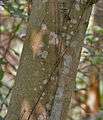Trema (plant)
| Trema | |
|---|---|
 | |
| Flowers & leaves of T. orientalis at Kolkata, West Bengal, India | |
| Scientific classification | |
| Kingdom: | Plantae |
| (unranked): | Angiosperms |
| (unranked): | Eudicots |
| (unranked): | Rosids |
| Order: | Rosales |
| Family: | Cannabaceae |
| Genus: | Trema Lour. |
| Species | |
|
About 15 species; see text | |
| Synonyms | |
| |
Trema is a genus of about 15 species of evergreen trees closely related to the hackberries (Celtis), occurring in subtropical and tropical regions of southern Asia, northern Australasia, Africa, South and Central America, and parts of North America.[1] They are generally small trees, reaching 10–20 m (33–66 ft) tall.
Taxonomy
Previously included either in the elm family, Ulmaceae, or with Celtis in the Celtidaceae, genetic analysis has shown the Celtidaceae are best placed in the hemp family, Cannabaceae.[2]
Description
The leaves are alternate, simple, 7–15 cm (2.8–5.9 in) long, ovate-acuminate to lanceolate with a long pointed tip, and evenly serrated margins. The fruit is a small drupe 3–5 mm (0.12–0.20 in) in diameter.
Species associations
Trema species are sometimes used as food plants by the larvae of hepialid moths of the genera Aenetus, including A. splendens, which burrow horizontally into the trunk then vertically down, and Endoclita, including E. malabaricus.
Uses
Trema orientalis is widely planted for land reclamation in southern Asia, valued for its tolerance of poor soils due to its ability to fix nitrogen. It is also an invasive species on some Pacific Ocean islands.
 Bark of T. orientalis at Kolkata, West Bengal, India
Bark of T. orientalis at Kolkata, West Bengal, India_W_IMG_2236.jpg)
_W2_IMG_2237.jpg)
_W2_IMG_2236.jpg)
 Branches of T. orientalis at Kolkata, West Bengal, India
Branches of T. orientalis at Kolkata, West Bengal, India
Selected species
- Trema cannabina Lour. – Lesser trema
- Trema cubense Urb.
- Trema discolor (Brongniart) Blume
- Trema domingensis Urb.
- Trema integerrima (Beurl.) Standl.
- Trema lamarckiana (Roem. & Schult.) Blume – West Indian trema, Lamarck's trema
- Trema micrantha (L.) Blume – Jamaican nettle tree
- Trema orientalis (L.) Blume – Pigeon wood
- Trema philippinensis Elmer
- Trema strigilosa Lundell
- Trema tomentosa (Roxb.) H.Hara – Poison peach
- Trema tomentosa var. viridis (Planch.) Hewson
T. tomentosa var. viridis is a common shrub or small tree throughout eastern Australia.
References
- ↑ "Trema micrantha (L.) Blume Jamaican nettletree". The PLANTS Database. United States Department of Agriculture. Retrieved 2009-10-06.
- ↑ Sytsma, Kenneth J.; Morawetz, Jeffery; Pires, J. Chris; Nepokroeff, Molly; Conti, Elena; Zjhra, Michelle; Hall, Jocelyn C. & Chase, Mark W. (2002), "Urticalean rosids: circumscription, rosid ancestry, and phylogenetics based on rbcL, trnL-F, and ndhF sequences", American Journal of Botany, 89 (9): 1531–1546, doi:10.3732/ajb.89.9.1531, PMID 21665755
External links
| Wikimedia Commons has media related to Trema (plant). |
| Wikispecies has information related to: Trema (plant) |